
 |
I'll have to go see it, because I'm usually a fan of European modernism, but I find the big lettering everywhere rather off-putting. Having a version of the current CTA logo on the station is one thing, but the big MORGAN STATION on the bridge beam just seems like an engineering firm's idea of cheap decoration. It's like a tramp stamp for infrastructure, and will be just as regrettable in 30 years.
|
Agreed, mostly - the typography isn't even very distinctive. I understand the desire to match the Helvetica of CTA's graphic standards, but as a large-scale piece of public art it just comes off as bland and soulless. It seems almost like the designers were trying to seed a new neighborhood name, but this area is already known as Fulton Market. I suppose there's still time for the name to catch on, though.
Conceptually, I like the idea of CTA starting to use typography in a decorative sense, as super-graphics or some more restrained format, but the current graphic standards are not meant for this. Also - let's hope the CTA doesn't change logos anytime soon. |
It's funny you said that about the new neighborhood name, in one of the pictures by markh9 at the top of this page because you can see a Fulton Market sign on one of the chimneys of a building behind the station
|
I was at the Morgan stop yesterday. It looks really good - it's what all the Brown Line stops should have looked like, in my opinion.
Some of the trains don't have announcements with Morgan on them yet. I ate dinner in Douglas Park last night and on the way back downtown on the Pink Line, they announced Clinton after Ashland. They did stop at Morgan, but it wasn't in the announcements. One of the coolest things, actually, are the cool sculptural bike rakes they have on each corner. |
More Morgan Station photos via Steven Vance via Grid.
I for one would like a lot more of these. Oversized type and all.  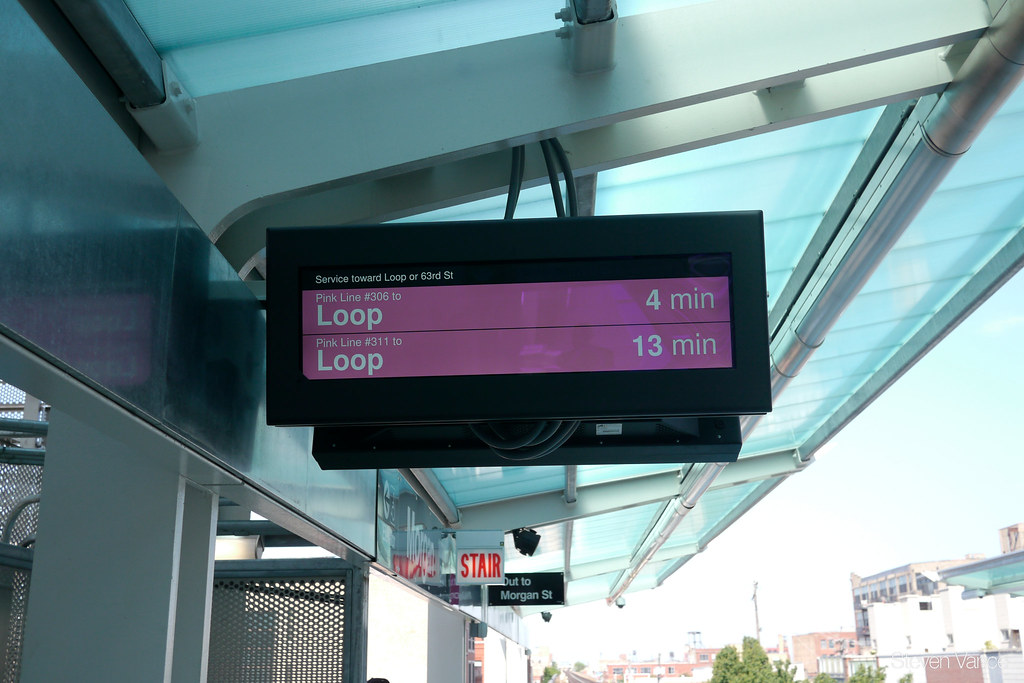 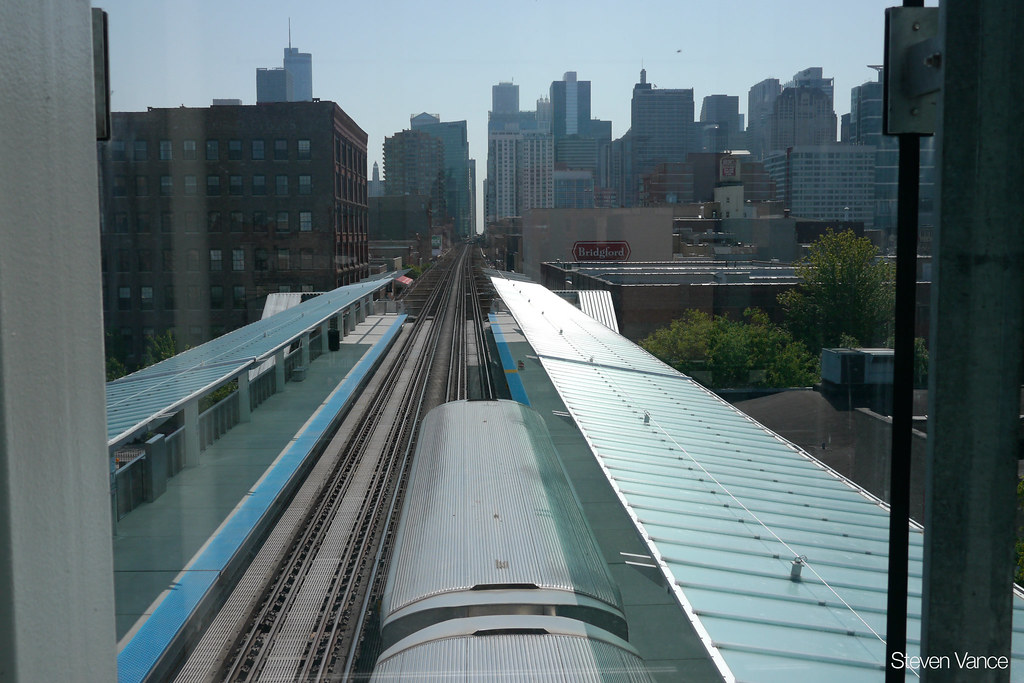 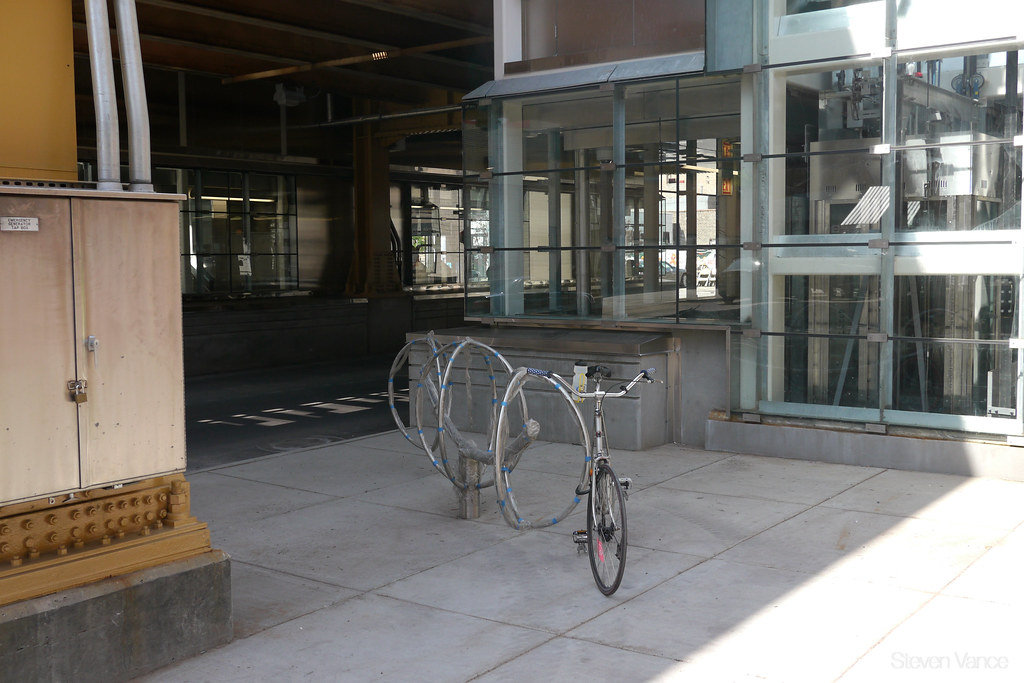 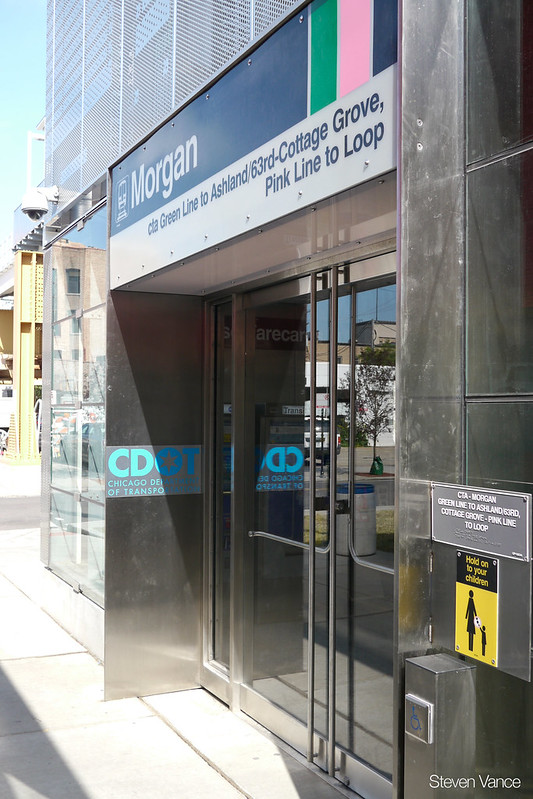 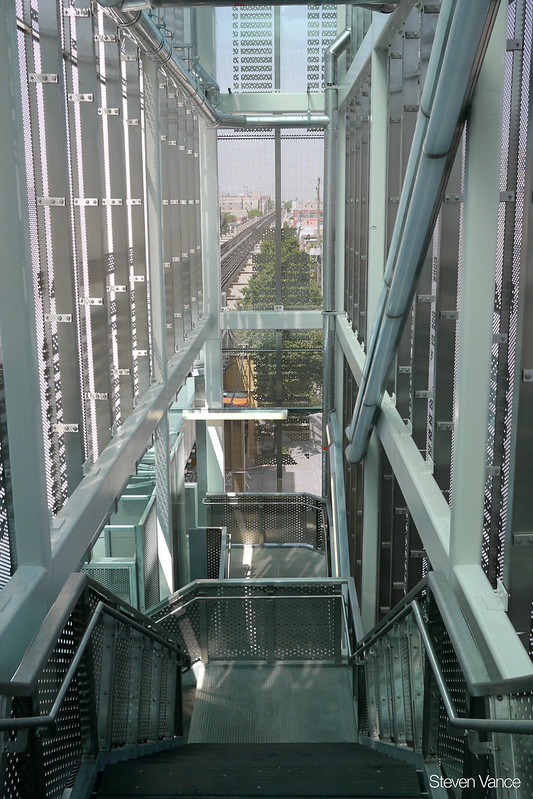 |
Looks pretty good!
|
The new compact LCD screens are great. They don't block sight lines and they don't show a bunch of useless ads whenever you're trying to check the arrival times. Here's hoping they roll 'em out at more stations.
|
I could do without the CDOT signage at the entrances though. Seems confusing, and I don't recall seeing them at other stations. If they are there they certainly aren't as pronounced.
|
AWESOME!
I hope this sets a new design standard for the CTA |
Wow! The Morgan station looks BADASS. I'm just wondering how long it'll take for those idiot street thugs to "rough it up" a little ...
|
Quote:
Don't know why its displaying a sad face that was inadvertant |
Yeah, the Morgan station looks great! I saw it last weekend when I was visiting the area. I, too, hope that it can serve as a design template for future CTA developments.
Quote:
|
Quote:
Damn, you're hard to please |
Quote:
Quote:
|
Quote:
Urban frontier is right, beautiful area, OK people, tons of potential. |
Quote:
Quote:
Quote:
Quote:
Quote:
I had a dish they called Filete En Hoja De Mazorca, which was a fish fillet wrapped with a corn leaf and stuffed with tomato, jalapeno and onions. I really liked it. That one is tilapia, but they also have a similar dish using tuna wrapped in a banana leaf. |
I'll have to try that when I'm down there next. That's like 3 or 4 blocks from my building.
|
Quote:
Yes Douglas Park is the urban frontier and it has quite a bit of potential may be a new emerging hot area. Yes you are right the area directly around the Morgan station is not the urban frontier; in fact I ate on Randolph yesterday. Ironic considering you were probably typing while I was eating. |
The Station looks really nice, but I'm not convinced it will be as forgiving to vandalism and the cold Chicago winters. Polycarbonate panels used as roofing tend to get a grimy appearance fast. And while I realize they are lightweight and easy to swap out, I think a Kalwall solution would have been more appropriate.
I cringe at the stainless steel near the entry. It should be granite. People are going to mar that up with markers and stickers. Someone will lean against it and scrape it up. The fingerprints are enough to distract from the aesthetic of the material. It also looks like there's lots of "dust shelf" and "garbage gap" opportunities where debris will pile up in the stairways. Anyone who has really looked at the Fullerton and Belmont stations sinced they opened will know what I mean. Again I find the architecture very nice, but from a maintenance standpoint I'd be very concerned. These issues need to be very well thought out since money for upkeep is tight. |
Morgan Station (Morgan & Station)
(Taken by me)
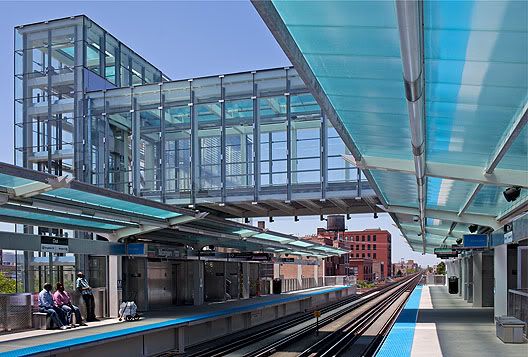 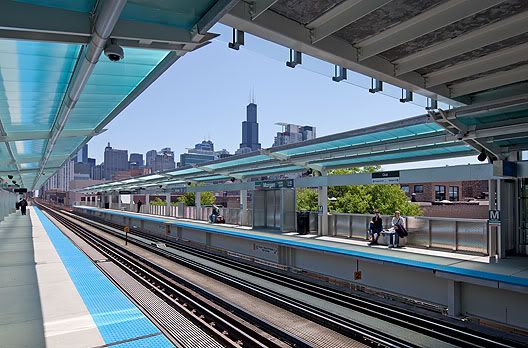 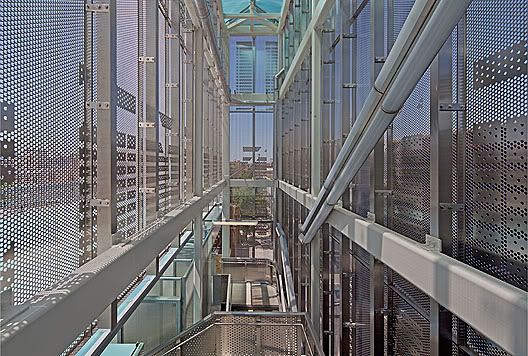  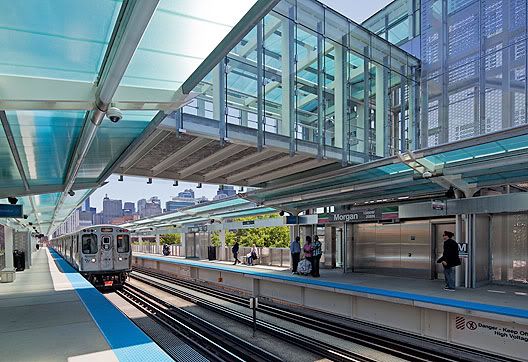    |
Put Chicago on the path to an electrified Metra
http://gridchicago.com/2012/put-chic...trified-metra/
Reactions to CDOT’s Chicago Forward Action Agenda vary Quickly: Union Station Master Plan study released today at breakfast on vintage train Put Chicago on the path to an electrified Metra by GUEST CONTRIBUTOR on MAY 23, 2012 · 10 COMMENTS AND 6 REACTIONS Ed. note: Roland Solinski is a graduate student of architecture at Tulane University. “I am a Chicagoan by birth and the city runs in my blood. I’m fascinated by all aspects of urban design and urban systems, but especially transit systems and public space.” Photo is of a southbound Metra Electric train. In November of 2010, the Chicago Tribune published an article that shocked Metra commuters. In it, Tribune reporters revealed that massive quantities of diesel exhaust were hanging in the air on platforms at Union Station and Ogilvie Transportation Center. Worse, the atmosphere inside each railcar contained the same exhaust at even higher concentrations – 72 times that of a normal city street. In numerous other cities, commuters do not need to worry about harmful exhaust fumes, because their trains run off of electric power. In fact, many cities installed rail electrification systems at the turn of the last century specifically to eliminate toxic smoke emissions, including the Illinois Central’s line right here in Chicago, now called Metra Electric. Clean air is just a side effect; electric trains offer a whole range of benefits with enormous potential. Just like a Porsche with a finely-tuned engine, modern electric trains accelerate at a much greater rate than Metra’s outmoded diesel locomotives. Since Metra stops are so close together, particularly in inner suburbs, trains currently spend a lot of time accelerating and slowing down, often not even reaching their 70 MPH speed limit. Alternatively, many Metra trains save precious time by simply running express and skipping whole groups of stations, benefiting outer suburban residents at the expense of inner-suburban and city residents. A fast-accelerating electric train could substantially shorten travel times and improve service for all Metra riders by bringing the train up to top speed faster. With greatly reduced travel times, Metra could then consider a few new stations along its lines, making additional stops without inconveniencing far suburban riders. These new stations would fall particularly within the City of Chicago, where stations are currently very infrequent (aside from the Metra Electric line). Metra’s own ridership statistics, available on RTAMS, suggest that new stations inside the city would be very popular, so long as Metra’s express trains do not skip them altogether – for example, Ravenswood is currently the busiest station on the UP-North line after Ogilvie itself. An electric commuter train in Montréal, Québec. Photo by Sean Marshall. All these facts indicate that electrification could spur significant regional changes. It would enable a new kind of Metra service with 15-minute frequency and faster travel times – essentially an extension of the city’s rapid-transit network. Just like the ‘L’, electrified Metra service could transform Bungalow Belt neighborhoods and inner-ring suburbs into heavily transit-oriented areas, offering them the same fast service into downtown that many city residents currently enjoy while raising property values and encouraging infill development. Through electrification and proper planning, these benefits are achievable at a fraction of the cost of expanding the ‘L’. In the 21st century, Metra needs to take a long, hard look at electrifying its busiest lines. Partially in response to the diesel-fumes debacle, Metra hosted a workshop on electrification in 2011. More of an industry symposium than a serious study, the workshop’s announcement still gave the impression that Metra was ready to start asking serious questions. However, the workshop documents do not even hint at a plan for Metra to move forward on studying electrification, suggesting that Metra officials are dismissive of the whole concept. In the same documents, those officials cite various reasons and excuses for why electrification wouldn’t work in Chicago – despite the fact that it already does and has for over a century on the Metra Electric. Although the officials did a good job of laying out the technical challenges, many of those challenges seem to be strongly overstated. One official contends that low clearance on overhead bridges may restrict the installation of modern overhead wire along Metra lines, yet Metra Electric has some of the city’s lowest overpasses and seems to run just fine. In a similar vein, the tall double-stack cars that some freight railroads use to move shipping containers might force Metra to install the wire higher than normal. Finally, the construction of an electric system is expensive, including overhead wire, substations spaced out along the line, and new electric trains themselves. These objections, however, are not nearly enough to doom electrification to the scrap heap of failed ideas. Instead the health benefits, savings on diesel fuel, and most importantly the faster acceleration and better service are well worth the investment for Chicago, and will save money over time for Metra and Chicago-area taxpayers while spurring sustainable transit-oriented development. The VIRM electric train in the Netherlands, which is for commuting and intercity passengers, uses a split-level carriage design. You enter on a plane level with the platform and then either traverse stairs going up or down. The platform-level deck, at each end of the carriage, holds the space for passengers with mobility devices or bicycles. The process would take time. Metra is a patchwork of rail lines owned by various railroads, and each line poses its own challenges – some more difficult than others. Metra itself owns the two Milwaukee District lines, the Rock Island, and the Metra Electric. On these lines, electrification can proceed easily (Metra Electric notwithstanding). The remaining six lines are owned by freight railroads, who would need to agree to the electrification. Initially after installation, Metra could swap out its aging diesel locomotives for electric ones. In fact, Metra could even purchase dual-mode locomotives to start taking advantage of the electric system before it’s even finished. These would produce no fumes and burn no costly diesel fuel on electrified segments of track, and would allow Metra to use its current fleet of railcars. However, they would not have the full benefits of acceleration and improved service. For that, Metra would need to purchase electric multiple units (EMUs) like those that Metra Electric runs. EMUs have no locomotive, but instead are simply a series of passenger cars with small motors in each one that work in sync to move the train. How much would this all cost? We can get a good sense by looking at Caltrain, which is in the midst of planning an electrification project of its own. Caltrain is very similar to a Metra line, with two tracks, high ridership, and relatively frequent stations. It runs from San Francisco to San Jose, California. Currently, cost estimates for the electrification system are roughly $950 million for 52 miles of track, or $18 million per mile. This is a high end estimate; some projects have cost far less. Amtrak electrified the Northeast Corridor between New Haven and Boston in the 1990s, spending $475 million for 157 miles of track. Adjusted for inflation, that project cost only $4 million per mile. Metra’s BNSF is a good candidate for electrification; it has Metra’s highest ridership and a series of closely-spaced stations between Cicero and Lisle. Using the two previous cost figures as a range, it would cost between $675 million and $150 million to electrify the 37.5-mile BNSF. This is a huge range to be sure, but even at the high end the cost is only $10,448 for every existing weekday rider. If Metra can hold costs down to Amtrak levels, the cost is only $2,500 per existing rider. When stops like Brookfield, Riverside, and Berwyn start to see much higher service frequencies, the ridership is sure to grow dramatically, increasing revenue. On the other hand, high diesel fuel costs will be replaced with a comparatively low electric bill, decreasing expenses. Both of these changes together create substantial room in Metra’s budget that can go towards the construction and maintenance of an electrified system. Electrification has the potential to improve or solve many problems facing Metra and the Chicago region. The savings on fuel will improve Metra’s bottom line and make it virtually immune to changing fuel prices, while the elimination of emissions will dramatically improve air quality around each line. Most importantly, electrification could begin to alter the fabric of Chicagoland, stitch the region back together and link inner-ring suburbs both to downtown and to growing areas farther out, all while costing far less than expanding the ‘L’. In an era of ever-shrinking public resources, ever-growing demand for transit, and stiff global competition among cities, Chicago can’t afford to spend too much on transit or to be satisfied with the status quo. Electrifying Metra is the right move to make. |
^^^ I would love to see this happen, but it seems that having multiple ownerships and freight considerstions really hampers any widespread implementation.
I could see The Metra owned Rock Island making the transition, the proposed SES and possibly the BNSF only if they move it to the LaSalle Street station. But piece mealing various lines that run into Union and Ogilvie seems far fetched. I imagine it being an 'all or nothing' situation. |
I don't see why it needs to be so dramatic. You electrify the lines one by one in a gradual process, starting with the easy ones (Milw, RI, SWS) and moving on to the most difficult ones (BNSF, UP-W). Heritage Corridor isn't worth the expense given ridership levels; neither is NCS.
|
Here's my Proposed Metra System extensions...etc infill stations...i'm still doing the Map , so I only have the station by Station guide...and only Ogilvie Transportation Center. Picture this an Electrified Ogilvie Network...I will have the Map up by Sunday along with the rest of the Metra Network.
Current , Proposed & Planned Stations Union Pacific/North Line Ogilvie Transportation Center Clybourn Ravenswood - Evanston Rogers Park - Evanston Main Street - Evanston Davis Street - Evanston Center Street - Evanston Wilmette Kenilworth Indian Hill - Winnetka Winnetka Hubbard Woods - Winnetka Glencoe Braeside - Highland Park Ravinia Park - Highland Park Ravinia - Highland Park Highland Park Highwood Fort Sheridan Lake Forest Lake Bluff Great Lakes - Lake Bluff North Chicago Waukegan Zion Winthrop Harbor Kenosha North Kenosha - Carthage College Mount Pleasent Racine North Bay - Racine Oak Creek South Oak Creek South Milwaukee Cudahy Harborview - Milwaukee Milwaukee Union Pacific/West Line Ogilvie Transportation Center Kedzie Oak Park Riverforest Maywood Melrose Park Bellwood Berkeley Elmhurst Villa Park Lombard Glen Ellyn College Avenue - Wheaton Wheaton Winfield West Chicago Geneva La Fox Elburn Maple Park Cortland Dekalb Rochelle Union Pacific/Northwest Line Ogilvie Transportation Center Clybourn Irving Park Jefferson Park Gladstone Park Norwood Park Edison Park Park Ridge Dee Road - Park Ridge Des Plains Cumberland - Des Plains Mount Prospect Arlington Heights Arlington Park - Arlington Heights Palatine Barrington Fox River Grove Cary Pingree Road Crystal Lake Ridgefield Woodstock Harvard Sharon Clinton Janesville Union Pacific/Northwest Line (McHenry Branch) Ogilvie Transportation Center Clybourn Irving Park Jefferson Park Gladstone Park Norwood Park Edison Park Park Ridge Dee Road - Park Ridge Des Plains Cumberland - Des Plains Mount Prospect Arlington Heights Arlington Park - Arlington Heights Palatine Barrington Fox River Grove Cary Pingree Road Prairie Grove McHenry Johnsburg Ringwood Richmond Genoa City Pell Lake Lake Geneva Elkhorn Delavan Next To tackle : Rock Island & Metra Electric Network |
Current , Proposed & Planned Stations
Electrified Rock Island Disrect Rock Island District - Main line LaSalle Street 'Lou' Jones/Bronzeville 95th Street - Longwood 103rd Street - Washington Heights Blue Island - Vermont Street Robbins Midlothian Oak Forest Tinley Park Tinley Park - 80th Avenue Mokena - Hickory Creek Mokena - Front Street New Lenox Joliet Rockdale Minooka Morris Seneca Marseilles Ottawa La Salle Rock Island District - Beverly Hills Branch LaSalle Street 'Lou' Jones/Bronzeville Brainerd 91st Street - Beverly Hills 95th Street - Beverly Hills 99th Street - Beverly Hills 103rd Street - Beverly Hills 107th Street - Beverly Hills 111th Street - Morgan Park 115th Street - Morgan Park 119th Street - Blue Island 123rd Street – Blue Island Prairie Street - Blue Island Blue Island - Vermont Street Robbins Midlothian Oak Forest Tinley Park Tinley Park - 80th Avenue Mokena - Hickory Creek Mokena - Front Street New Lenox Joliet Southwest Service LaSalle Street 'Lou' Jones/Bronzeville South Ashland - West Englewood Wrightswood Ashburn Oaklawn Chicago Ridge Worth Palos Heights Palos Park Orland Park 143rd Street Orland Park 153rd Street Orland Park 179th Street Laraway Road - New Lenox Manhattan |
Current , Proposed & Planned Stations
Metra Electric - Main line Millennium Station Van Buren Street Museum Campus/11th Street 18th Street McCormick Place 27th Street Kenwood/47th Street Hyde Park/53rd Street 55th–56th–57th Street 59th Street 63rd Street 75th Street-Grand Crossing 79th Street-Chatham Avalon Park-83rd Street Woodruff-87th Street Chesterfield-91st Street 95th Street – Chicago State University 103rd Street-Rosemoor 107th Street Station Pullman/111th Street Kensington/115th Street Riverdale Ivanhoe 147th Street / Sibley Boulevard Harvey Hazel Crest Calumet Homewood Flossmoor Olympia Fields 211th Street-Lincoln Highway Matteson Richton Park University Park Monee Pentone Manteno Bourbonnais Bradley Kankakee Metra Electric Blue Island Branch Millennium Station Van Buren Street Museum Campus/11th Street 18th Street McCormick Place 27th Street Kenwood/47th Street Hyde Park/53rd Street 55th–56th–57th Street 59th Street 63rd Street 75th Street-Grand Crossing 79th Street-Chatham Avalon Park-83rd Street Woodruff-87th Street Chesterfield-91st Street 95th Street – Chicago State University 103rd Street-Rosemoor 107th Street Station Pullman/111th Street Kensington/115th Street State Street Stewart Ridge West Pullman Racine Ashland Blurr Oak Blue Island Metra Electric Chicago Branch Millennium Station Van Buren Street Museum Campus/11th Street 18th Street McCormick Place 27th Street Kenwood/47th Street Hyde Park/53rd Street 55th–56th–57th Street 59th Street 63rd Street Stony Island Bryn Mawr South Shore windsor Park Cheltenham 83rd Street 87th Street South Chicago (93rd Street) Metra Electric Chicago Heights Branch Millennium Station Van Buren Street Museum Campus/11th Street 18th Street McCormick Place 27th Street Kenwood/47th Street Hyde Park/53rd Street 55th–56th–57th Street 59th Street 63rd Street 75th Street-Grand Crossing 79th Street-Chatham Avalon Park-83rd Street Woodruff-87th Street Chesterfield-91st Street 95th Street – Chicago State University 103rd Street-Rosemoor 107th Street Station Pullman/111th Street Kensington/115th Street Golden Gate Dolton South Holland Thorton Chicago Heights South Chicago Heights Crete Up Next : South Shore Network |
As CTA Gray Line notes, the Union Station Master Plan is out.
It's a big report and it makes a lot of recommendations. Here are a few that caught my eye. 1. Through tracks for all platforms are out of the question. The tracks don't line up and demolishing everything built over them to make them line up is just not feasible. Demolishing 222 Riverside would allow for some of the tracks to be linked, but extremely long platforms with a jog in the middle, or two sets of platforms arranged end-to-end with crossovers in the middle, with no discernable way to access them from the head house, is also not particularly useful. 2. Platforms with through tracks CAN be added by converting the old mail platforms. and/or by building them under Clinton/Canal. (1 level/2 platforms/4 tracks under Canal; 2 levels/2 platforms/4 tracks under Clinton.) Building new tracks under Clinton/Canal will be challenging since it will require slow and expensive stacked drift excavation under Fulton Station Condominums. 3. It will be possible to add a fourth surface-level northern lead track but it will require A. rebuilding the 100 year old CNW viaduct that carries the UP metra lines into Ogilvie (which will need to be done eventually anyway) and B. a small right-of-way dedication from River Point/444 W Lake. 4. The report recommends eventually widening all the south platforms by removing the baggage platforms, but makes no mention of doing the same for the north platforms. |
^^^^On the UP North line there is a proposed station at Peterson that I do not see listed. My sources tell me that this station is as good as set. between ridge and peterson north of peterson. Also neither rogers park nor ravenswood are in Evanston they are firmly in Chicago
|
Quote:
|
Quote:
|
Quote:
I will take back everything I said if you do not include a South Shore extension into Michigan paralleling CSX track on your next update. That would really help me out. There is only one bridge between Michigan City and St. Joseph and that would be about equal distance as South Bend, so I cannot imagine that the cost would be astronomical. But that won't happen because there is no way three different States can come together with an acceptable plan. OT political rant-Those of us that live where four States intersect do believe that there is a place for the federal government in the world. My life is very much affected by the decisions Wisconsin, Illinois, Indiana and Michigan make. Pollution, transportation policy, education, etc. cannot be decided purely in a local void. -end OT political rant. Please feel free to ignore. |
Between Population growth and Reverse Ridership I think those extensions are justified. I was just thinking about the servicing the Eastern Illinois , Southern Wisconsin & Northern Indiana as part of a huge Regional Rail network....100 miles of Electrified lines isn't that long , as 100 miles diesel....in terms of Travel times...
|
Quote:
|
Rather than an extension of South Shore, it would be easier just to add frequency to the existing Pere Marquette. A new track connection could allow the Pere Marquette to stop in New Buffalo as well.
Other outward expansions proposed by Nexis could also be operated by Amtrak, particularly the Rock Island (which should really go all the way to Peoria). The state-subsidy model pretty much makes Amtrak into another commuter-rail agency, one that isn't legislatively restricted to six IL counties. |
Current , Proposed & Planned Stations
South Shore Network Main line Millennium Station Van Buren Street Museum Campus/11th Street 18th Street McCormick Place 55th–56th–57th Street 63rd Street Hegewisch Hammond East Chicago Gary Airport Gary Metro Center Miller Portage / Ogden Dunes Dune Park Beverly Shores 11th Street Carroll Avenue Hudson Lake Lydick South Bend Airport Lowell Branch Millennium Station Van Buren Street Museum Campus/11th Street 18th Street McCormick Place 55th–56th–57th Street 63rd Street Hegewisch Downtown Hammond 173rd Streeet - Hammond Highland Schererville St. John Lowell Valparaiso Branch Millennium Station Van Buren Street Museum Campus/11th Street 18th Street McCormick Place 55th–56th–57th Street 63rd Street Hegewisch Hammond East Chicago Gary Airport Broadway - Gary Interstate 94/65 Park - Ride - Gary Hobart Wheeler Valparaiso Goshen Extension Millennium Station Van Buren Street Museum Campus/11th Street 18th Street McCormick Place 55th–56th–57th Street 63rd Street Hegewisch Hammond East Chicago Gary Airport Gary Metro Center Miller Portage / Ogden Dunes Dune Park Beverly Shores 11th Street Carroll Avenue Hudson Lake Lydick La Salle Park Downtown South Bend / (New Amtrak) Ironwood Dr - Indiana University South Bend Mishawaka Elkhart Goshen St. Joesph Branch Millennium Station Van Buren Street Museum Campus/11th Street 18th Street McCormick Place 55th–56th–57th Street 63rd Street Hegewisch Hammond East Chicago Gary Airport Gary Metro Center Miller Portage / Ogden Dunes Dune Park Beverly Shores Michigan City North Long Beach Michiana Shores New Buffalo Union Pier Bridgman Lincoln Charter St. Joesph Benton Harbor Next and last : Union Station Network |
Quote:
UP-N [Kenosha to Milwaukee] 35+ Miles UP-W [Elburn to Rochelle] 33+ Miles UP-NW [Harvard to Janesville] 35+ Miles UP-NW [McHenry to Lake Geneva] 20 Miles RI [Joliet to LaSalle] 60 Miles ME [University Park to Kankakee] 25 Miles I could see an extension to Milwaukee making sense as it would allow easier transit between both cities and could act as a commuter line for people who work in Mailwaukee as well. But none of the others make sense to me as full time lines that flow straight through to downtown Chicago. Quote:
|
Quote:
1. Set price tickets. I routinely do not take Pere Marquette because GRR passengers push tickets to SJM above 20 dollars one way. NICTD South Bend fare is 11.75 so lets assume I can buy a fare from St. Joseph for 14 dollars at the last minute as opposed to being faced with 29 dollar Amtrak tickets. 2. Local funding would pay for South Shore operation, where as Amtrak expansion would hinge on Lansing support. If you can get costs low enough by piggy backing with NICTD, Berrien County could go it alone and not have to worry about convincing Detroit and Lansing politicians that such a connection is worthwhile. Berrien County is Republican territory but the majority I would describe as pragmatic as opposed to dogmatic. Present them with a plan that will have enough upside, and somehow get second homeowners to pay for the majority of the costs, and I could see a local funding source established. I don't see Michigan paying for increased Amtrak usage on its least busy route any time soon. |
The airline-style pricing on Amtrak is a consequence of the limited capacity (since the trains are so infrequent). I believe Hiawatha has fixed prices; so does the Capital Corridor in California.
With regard to the STAR Line: increased frequency on the existing lines is an absolute requirement for the STAR Line to be successful. The whole concept of an orbital line is based on the ability to quickly and easily make a transfer between lines; how are people supposed to do that when the frequency is so low? They'll face 20 or 30 minute waits at the transfer points. Plus, those transfer points are in the middle of nowhere by design; the EJ&E was laid out a century ago to avoid the town centers. That means the line doesn't have any destinations along it. It would be like the Heritage Corridor or North Central, except with half the ridership and ten times the cost. The entire orbital part of the STAR Line is a gimmick to get all of suburban Chicago to support a line that really only benefits the I-90 corridor. |
Anything new on the new Cermak station on the Green Line? Have they started building it? I read it's going to be two years before it's done.
|
Quote:
|
The report allows for the possibility of demolishing 222 S. Riverside, but only if it is replaced with another office tower. Presumably, this could be designed with huge column spans like the Daley Center and substantial open space at grade and below.
|
Quote:
The good thing about the Union Station master plan is that the short and medium solutions will do a lot to improve operations. Moving ticketing and the Lounge out of the basement, redoing the bathrooms and coach waiting areas, moving escalators, and removing walls will do a lot to open it up. Granted it would be nice to see 222 Riverside go but what I really care about is improving the experience. Get me on and off a train as easily as possible and I will be happy, even if that means that there are no through tracks and 222 stays. |
I was wondering if there was a rail engine that ran exclusively on batteries, and I found these articles:http://rps.psu.edu/indepth/norfolk_southern.html and http://www.nscorp.com/nscportal/nsco...batteries.html. If this technology improves, you wouldn't need to electrify the entire rail line, especially those which are owned by freight companies.
I don't know if the batteries would have enough juice to go the entire day, and power all the remaining passenger cars (lighting, doors, etc). In fact, here is another article about trying to use fuel cells to power a locomotive http://www.railwaygazette.com/nc/new...fuel-cell.html. This is much more experimental than the battery locomotive, but would still be cheaper than converting to an electrified system. |
Quote:
I had an idea like that last year, and created an extremely unsuccessful Website for it: http://regenerativehybridunit.yolasite.com/ |
Also, we discussed something along the lines of battery-powered locomotives a couple months ago, in this thread I think.
|
A man, a mission, a new Metra
http://chicagomaroon.com/2012/05/25/...n-a-new-metra/
A man, a mission, a new Metra One former Chatham resident has drafted a proposal for solving the South Side's transit woes, which most—but not all—have discounted. by Celia Bever - May 25, 2012 6:13 am CDT photo: sydney combs/the chicago maroon The proposed CTA Grey Line "L" Route would run along the Metra tracks closest to the lake. Michael Payne moved to the western suburbs from his South Side home nearly five years ago, but he still remembers the drudgery of commuting into the Loop for his job as an office repairman—and the hour-long bus rides that he had to take to the closest Red Line stop before moving even an inch northward. These memories, coupled with a lifelong interest in trains, prompted Payne to work for 16 years on a proposal to improve public transit to the South Side: the Chicago Transit Authority (CTA) Gray Line L Route Project. Though neither Metra nor CTA are currently considering his plans, Payne, 63, has opened the way for other projects and has caught the eye of advocates for transit reform. His stint at a railroad company in the 1970s allowed him to plan, perfect, and lobby for the Gray Line, which would convert the two inner tracks of the Metra Electric District into L lines. Trains with new decals would run every 10 minutes instead of every hour, as they sometimes do now, and turnstiles and fare boxes would be installed at stations. Metra personnel would continue to staff the trains. Payne estimates that the project would cost $200 million, create 8,000 to 10,000 permanent jobs, and encompass 40 stops over 25 miles. In contrast, he said, Mayor Rahm Emanuel's proposed Red Line extension would cost about $1.4 billion for three stops along five miles. The Gray Line was ranked first in a 2003 study of city public transit projects by the Chicagoland Transportation and Air Quality Commission. However, CTA found that Payne's plan inadequately addresses South Side transportation needs that are better served by the Red Line extension, which would run up to Howard Street, while the Gray Line would stop at Millennium Park, according to CTA spokesperson Catherine Hosinski. Payne responded that passengers could transfer from the Gray Line to other CTA trains to go farther north. Hosinski also said that the Gray Line would not be able to run as frequently as Payne desired because the Metra tracks cannot be shared between trains as efficiently as CTA tracks. Payne claims that the real problem is tensions between Metra and CTA. "It's completely, 100 percent political," he said. The Chicago Department of Transportation (CDOT) is leaning toward the less ambitious Gold Line, whose designers were inspired by Payne's work. "The Gray Line wasn't the option the community was most interested in," said Brenda McGruder, the coordinating planner at CDOT. The Gold Line, spearheaded by Southsiders Organized for Unity and Liberation (SOUL), would convert only the Metra's South Chicago branch, which runs along Lake Park Avenue. SOUL originally supported the more expansive Gray Line, but opted for a plan that seemed more feasible at the time. "We thought that was the most practical thing to do," SOUL board member Linda Thisted said. SOUL, along with Fourth Ward Alderman Will Burns, has successfully lobbied for the introduction of a universal fare card for CTA and Metra systems that will take effect in 2015. Payne, who also anticipated fares as one of the largest hurdles in improving transportation, is grateful for SOUL's work. "I never could have come up with that," he said. While struggling to find support for the Gray Line, Payne was let go from his repairman job in 2006, leaving him homeless, spending many nights sleeping on the L for six months. After finding his current job at a B.P. station outside the city, he moved and bought a car. "I'm a gas station attendant. I have no political power whatsoever." Yet Payne remains optimistic. Social security checks and a discount from a former employer have allowed Payne to print fliers that he plans to pass out at community meetings and on L stops. Though the Gray Line would no longer benefit him personally, he has no intentions of giving up now. "It's been a part of my life for too long," he said. |
The weekend needs to get here because I certainly have not been doing much work the past two days. In furtherance of this here are the extensions, I used 39 mph as the average speed for the extensions to estimate the travel times, that may be a little fast but it seemed reasonable. Populations are only for the city limits listed or noted otherwise, as bored as I am I could not do anything more.
line extension miles, total miles, travel times, population served UP-N [Chicago to Milwaukee] 32.4 miles, 84.3 miles, 2:29, Milwaukee+Racine 673,000 UP-W [Chicago to Rochelle] -,74 Miles, 2:05, Rochelle+DeKalb 50,000 UP-NW [Chicago to Janesville] 28.8 miles, 90 miles, 2:28, Sharon+Janesville 65,350 UP-NW [Chicago to Lake Geneva] 19.7 miles, 69.2 miles, 1:54, - RI [Chicago to LaSalle] 58.6 miles, 99 miles, 2:40, Morris-Seneca-Ottawa-LaSalle 49,039 ME [Chicago to Kankakee] 24.6 miles, 55.6 miles, 1:32, Kankakee-Bradley MSA 113,698 NICTD [Chicago to St. Joseph, MI] 33 miles, 91 miles, 2:30, 60,000 to 65,000 my estimate of SJ/BH area including SJ and Benton townships, etc. For comparison South Bend is one of the fastest growing in terms of ridership: South Shore [Chicago to South Bend, IN] -, 90 miles, 2:25 So the only one that is ridiculously long is out to LaSalle and electrification could drop some of those travel times. What South Shore does is run short trains from South Bend and add cars down the line. Gary Metro I think is one station where they add trains, others could probably help on how that works. So these extensions are not probable, nor worthwhile, but not too long as compared to South Bend. |
Quote:
|
METRA RER Network
Metra RER : North Central & BSNF Railway line Milwaukee Intermodal West Allis Parkland Green Waukesha Sunset Heights Mukwonago Burlington Silver Lake - Camp Lake Antioch Lake Villa Round Lake Beach Washington Street - Grayslake Prairie Crossing / Libertyville Mundelein Vernon Hills Prairie View Buffalo Grove Wheeling Prospect Heights O'Hare Transfer Rosemont Schiller Park Belmont Avenue River Grove Western Avenue Chicago Union Station Halsted Street Western Ave Cicero La Vergne Berwyn Harlem Avenue Riverside Hollywood Brookfield Congress Park La Grange Stone Avenue Western Springs Highlands Hinsdale West Hinsdale Clarendon Hills Westmont Fairview Avenue Downers Grove – Main Street Belmont Lisle Naperville Route 59 Aurora Montgomery Oswego Village Square Plano Sandwich Milwaukee Disrect North line & Heritage Corridor Richmond Spring Grove Fox Lake Ingleside Long Lake Round Lake Grayslake Prairie Crossing Libertyville Lake Forest Deerfield Lake Cook Road Northbrook North Glenview Glenview Golf Morton Grove Edgebrook Forest Glen Mayfair Grayland Healy Western Avenue Chicago Union Station Brighton Park Summit Willow Springs Lemont Lockport Joliet Presont Heights Elwood Wilmington Milwaukee Disrect West line Janesville Beloit Rockton Machesney Park Loves Park Rockford Valley View Belvidere Marengo Huntley Big Timber Elgin National Street Barlette Hanover Park Schaumburg Roselle Medinah Itasca Wood Dale Bensenville Mannheim Franklin Park River Grove Elmwood Park Mont Clare Mars Galewood Hanson Park Grand/Cicero Western Avenue Chicago Union Station |
Quote:
|
| All times are GMT. The time now is 8:33 PM. |
Powered by vBulletin® Version 3.8.7
Copyright ©2000 - 2024, vBulletin Solutions, Inc.